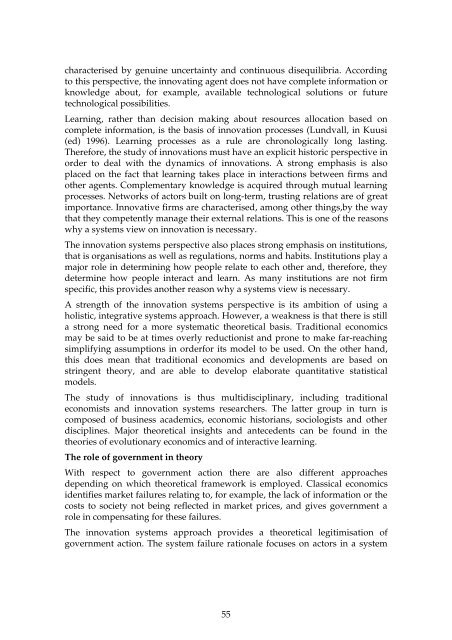Drivers of environmental innovation - Vinnova
Drivers of environmental innovation - Vinnova
Drivers of environmental innovation - Vinnova
You also want an ePaper? Increase the reach of your titles
YUMPU automatically turns print PDFs into web optimized ePapers that Google loves.
characterised by genuine uncertainty and continuous disequilibria. According<br />
to this perspective, the innovating agent does not have complete information or<br />
knowledge about, for example, available technological solutions or future<br />
technological possibilities.<br />
Learning, rather than decision making about resources allocation based on<br />
complete information, is the basis <strong>of</strong> <strong>innovation</strong> processes (Lundvall, in Kuusi<br />
(ed) 1996). Learning processes as a rule are chronologically long lasting.<br />
Therefore, the study <strong>of</strong> <strong>innovation</strong>s must have an explicit historic perspective in<br />
order to deal with the dynamics <strong>of</strong> <strong>innovation</strong>s. A strong emphasis is also<br />
placed on the fact that learning takes place in interactions between firms and<br />
other agents. Complementary knowledge is acquired through mutual learning<br />
processes. Networks <strong>of</strong> actors built on long-term, trusting relations are <strong>of</strong> great<br />
importance. Innovative firms are characterised, among other things,by the way<br />
that they competently manage their external relations. This is one <strong>of</strong> the reasons<br />
why a systems view on <strong>innovation</strong> is necessary.<br />
The <strong>innovation</strong> systems perspective also places strong emphasis on institutions,<br />
that is organisations as well as regulations, norms and habits. Institutions play a<br />
major role in determining how people relate to each other and, therefore, they<br />
determine how people interact and learn. As many institutions are not firm<br />
specific, this provides another reason why a systems view is necessary.<br />
A strength <strong>of</strong> the <strong>innovation</strong> systems perspective is its ambition <strong>of</strong> using a<br />
holistic, integrative systems approach. However, a weakness is that there is still<br />
a strong need for a more systematic theoretical basis. Traditional economics<br />
may be said to be at times overly reductionist and prone to make far-reaching<br />
simplifying assumptions in orderfor its model to be used. On the other hand,<br />
this does mean that traditional economics and developments are based on<br />
stringent theory, and are able to develop elaborate quantitative statistical<br />
models.<br />
The study <strong>of</strong> <strong>innovation</strong>s is thus multidisciplinary, including traditional<br />
economists and <strong>innovation</strong> systems researchers. The latter group in turn is<br />
composed <strong>of</strong> business academics, economic historians, sociologists and other<br />
disciplines. Major theoretical insights and antecedents can be found in the<br />
theories <strong>of</strong> evolutionary economics and <strong>of</strong> interactive learning.<br />
The role <strong>of</strong> government in theory<br />
With respect to government action there are also different approaches<br />
depending on which theoretical framework is employed. Classical economics<br />
identifies market failures relating to, for example, the lack <strong>of</strong> information or the<br />
costs to society not being reflected in market prices, and gives government a<br />
role in compensating for these failures.<br />
The <strong>innovation</strong> systems approach provides a theoretical legitimisation <strong>of</strong><br />
government action. The system failure rationale focuses on actors in a system<br />
55

















